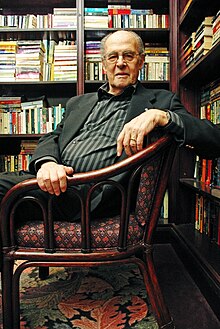Ronald Melzack
Ronald Melzack (born July 19, 1929 in Montreal , Province of Québec , Canada ; † December 22, 2019 there ) was a Canadian psychologist and pain researcher.
Melzack studied psychology at McGill University with a bachelor's degree in 1950, a master's degree in 1951 and a doctorate with Donald O. Hebb in 1954. He was 1954 to 1957 Research Fellow in Physiology at the Medical School of the University of Oregon , 1957/58 Lecturer in psychology at University College London and 1958/59 at the University of Pisa . From 1959 to 1963 he was an Associate Professor at the Massachusetts Institute of Technology , where he began working with Patrick David Wall . From 1963 he was a professor of psychology at McGill University. From 1970 he was director of pain research at the later pain clinic of the Montreal General Hospital, which he founded in 1974 with the head of neurosurgery Joseph Stratford (who became the medical director of the pain clinic). This was the first pain clinic in Canada.
In 1975 he developed the McGill Pain Questionnaire (McGill Pain Index)
With Patrick David Wall he introduced the gate control theory of the development of pain in 1965 . An important suggestion was the book by the Dutch neurosurgeon Willem Noordenbos , according to which there is a mechanism for suppressing and filtering the constantly occurring afferent stimuli to the brain (multisynaptic afferent system, MAS), with A fibers suppressing the pain-conducting C fibers. In the gate control theory there is a gate in the spinal cord, in which both fibers converge and interact. The pain stimuli can be passed through the C-fibers to the brain, but can also be blocked by other sensory stimuli or psychological effects via the A- fibers. After an initially rather negative reception, the theory prevailed on essential points.
With Wall he is the editor of an English-language standard work on pain and a popular science book on pain. He also examined phantom pain, stress-induced analgesia and developed the theory of the neuromatrix, according to which every human being has a genetically determined neural network that determines how sensed the body is, but can also cause phantom pain and chronic pain.
According to Melzack, there are two types of pain: sudden, short-lasting pain, which is mediated via the system that Melzack calls lateral and is transmitted in the brain stem to one side of the central nucleus, and long-lasting (for example chronic) pain that occurs in the (after Melzack) medial system (in the center of the brain stem).
From 1984 to 1987 he was President of the International Association for the Study of Pain (IASP), which he co-founded in 1973. He was a Fellow of the Royal Society of Canada , received the Order of Canada (1995) and the National Order of Quebec (2000). In 2009 Melzack was inducted into the Canadian Medical Hall of Fame . In 2010 he received the Grawemeyer Award in Psychology from the University of Louisville , the Killam Prize in 2001 and the Prix du Québec in 1994.
One of his PhD students is Nobel Prize winner John O'Keefe .
Fonts (selection)
- The puzzle of pain, Hippokrates Verlag 1978 (translation from: The puzzle of pain)
- with Patrick David Wall: The Challenge of Pain, Penguin 1982, 2nd edition 1989
- with PD Wall (editor): The Textbook of Pain, Churchill Livingstone 1983, 4th edition 1999, 5th edition 2005 (as Stephen B. MacMahon, Martin Koltzenburg (eds.), Wall and Melzack's Textbook of Pain )
- with Wall: Handbook of Pain Management: A Clinical Companion to Textbook of Pain, Churchill Livingstone 2003
Individual evidence
- ↑ Benedict Carey: Ronald Melzack, Cartographer of Pain, Is Dead at 90. In: The New York Times , January 12, 2020 (English). Retrieved January 13, 2020.
- ↑ Melzack, The McGill Pain Questionnaire: major properties and scoring methods , Pain, Volume 1 1975, pp. 277-299
- ^ R. Melzack, PD Wall: Pain mechanisms: a new theory, Science, Volume 150, 1965, pp. 971-979
- ↑ Noordenbos, Pain: problems pertaining to the transmission of nerve impulses, Elsevier 1959
- ↑ Sytze van der Zee, Pain, a Biography, Knaus Verlag, 2012
- ↑ Melzack, Pain and the Neuromatrix in the Brain, Journal of Dental Education, Volume 65, 2001, pp. 1378-1382
| personal data | |
|---|---|
| SURNAME | Melzack, Ronald |
| BRIEF DESCRIPTION | Canadian psychologist |
| DATE OF BIRTH | July 19, 1929 |
| PLACE OF BIRTH | Montreal , Province of Quebec , Canada |
| DATE OF DEATH | 22nd December 2019 |
| Place of death | Montreal , Province of Quebec , Canada |

